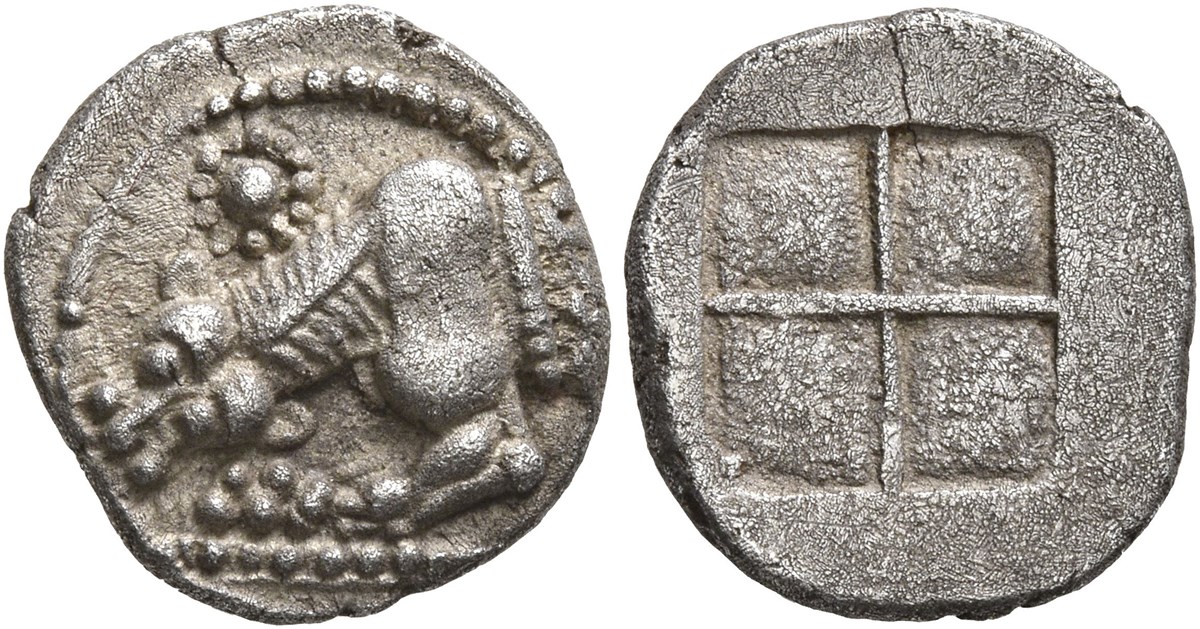S 1811 - Acanthus, silver, tetrobols (Period B) (500-478 BCE)
From SILVER
500 BCE - 478 BCE Silver 2,532 kg
Description
| ObverseInscription or printing placed on the obverse.: | Forepart of a lioness to left, head seen from above, above, rosette |
| ReverseInscription or printing placed on the reverse.: | Quadripartite incuse square with granulated recesses |
Mint and issuing power
| MintIdentifies the place of manufacture or issue of a numismatic object.: | Acanthus | Ancient regionAncient region.: | Macedon | Modern countryModern country: Greece | AuthorityIdentifies the issuing power. The authority can be "pretended" when the name or the portrait of X is on the coin but he/she was not the issuing power. It can also be "uncertain" when there is no mention of X on the coin but he/she was the issuing power according to the historical sources: |
Chronology
| FromIdentifies the initial date in a range assigned in a numismatic context. | 500 BCE | toIdentifies the final date in a range assigned in a numismatic context.. | 478 BCE | PeriodTime period of the numismatic object.: Archaic until 480 BC |
Physical description
| MetalThe physical material (usually metal) from which an object is made.: | Silver |
Median weightMedian of the weights of numismatic objects (in grams). in grams | 2.50 | DenominationTerm indicating the value of a numismatic object. Examples: tetradrachm, chalkous, denarius.: | tetrobol |
StandardStandard.: |
Image

S1811 Acanthus tetrobols B.jpg [1]
References
| Die study referencePublication of the study: | Tselekas 19961Tselekas 1996, p. 201-202, 207-208, 214-217 | ||
| Coin series referenceReference to coin series study: | Sear I2Sear I, n° 1273 | ||
| Coin series web referenceCoin series web references: | |||
Obverse dies distribution
| FrequencyFrequency of specimen in distribution. ᵖ | Number of obversesNumber of obverse dies. ᵖ (o) | % (o) | Number of coinsNumber of coins. (n) | % (n) | Die nameName(s) of the die(s). |
| 1 | 21 | 63.64 | 21 | 29.58 | 7, 8, 10, 13, 14, 15, 17, 19, 20, 22, 23, 24, 29, 30, 31, 32, 33, 34, 36, 37, 38 |
| 2 | 6 | 18.18 | 12 | 16.9 | 9, 11, 18, 21, 27, 35 |
| 4 | 2 | 6.06 | 8 | 11.27 | 12, 26 |
| 5 | 1 | 3.03 | 5 | 7.04 | 16 |
| 6 | 2 | 6.06 | 12 | 16.9 | 25, 28 |
| 13 | 1 | 3.03 | 13 | 18.31 | 6 |
| Total | 33 of 33 | 100 | 71 of 71 | 100 |
Reverse dies distribution
no distribution is available
Quantification
| Number of obversesNumber of obverse dies. ᵖ (o) | 33 | Number of singletons (o1)The number of singleton coins. ᵖ | 21 |
| Number of reverse diesNumber of reverse dies. (r) | 37 | Number of coinsNumber of coins. (n) | 71 |
| Coins per obverse dieNumber of coins per obverse die. (n/o) | 2.15 | Coins per reverse dieNumber of coins per reverse die. (n/r) | 1.92 |
| Reverse per obverse ratioRatio of obverse dies divided by reverse dies. (r/o) | 1.12 | Percentage of singletons (o1)number of coins (n) divided by the number of singletons (o1) ᵖ | 63.64 % |
| Original number of dies (O) (Carter 1983 formula)The estimation of the number of coins according to Carter 1983 ᵖ | 50.63 | Coins struck if 20,000 as average productivity per dieCoins made if the average productivity for obverses (according to Carter) is 20,000. ᵖ | 1,012,600 |
| Original number of dies (O) (Esty 2011 formula)The estimation of the number of coins according to the singleton formula in Esty 2011 ᵖ (O) | 61.66 | Survival rate if 20,000 as average productivity per dieSurvival rate if average productivity is 20,000. ᵖ | 0.00007 |
| Coverage (o = % of O) (Esty 1984 formula)Esty 1984 - coverage (% of O) ᵖ (o = % of O) | 70.42% | Die productivity if survival rate 1/2,000Average productivity if survival rate is 1/2,000. ᵖ | 2,804.66 |
| Weight of silver (in kg) if 20,000 coins per die (O = Carter formula)Carter 1983 * Median weight * 20000 (*10 if gold or electrum) ᵖ | 2,532 kg <br /> 2,532 kg | Die productivity if survival rate 1/5,000Average productivity if survival rate is 1/5,000. ᵖ | 7,011.65 |
Remarks